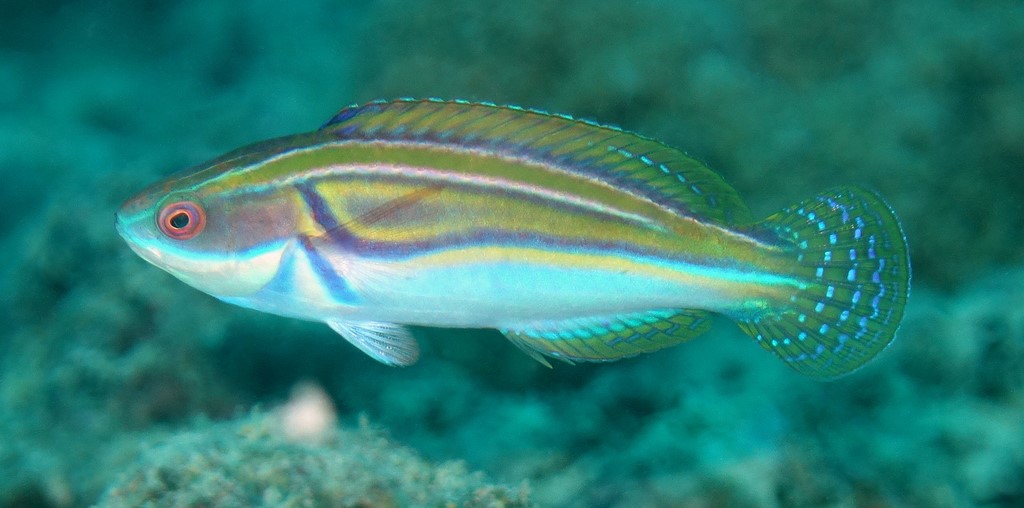CIRRHILABRUS LABOUTEI - (RANDALL & LUBBOCK, 1982)
Picture courtesy of: Alain Daoulas
Actinopterygii (Gigaclass) > Actinopteri (Class) > Teleostei (Subclass) > Labriformes (Order) > Labroidei (Suborder) > Labridae (Family) > Cirrhilabrus (Genus)
Labre de Laboute, Laboute's fairy-wrasse, Laboute's wrasse, Magenta-streaked wrasse, Northern purple wrasse, 拉氏丝隆头鱼,
Synonyme
Cirrhilabrus labouti (Randall & Lubbock, 1982)
------------------------
Description
Dorsal spines (total): 11; Dorsal soft rays (total): 9; Anal spines: 3; Anal soft rays: 8-9 (usually: 8); Pectoral fin rays: 15-16 (usually: 15); Median predorsal scales: 5; One row of scales on cheek (space for second scale occupied by two small scales, one above over); First two anal spines of males prolonged; Caudal fin rounded; Pelvic fins short. Max. length: 12.0 cm TL. Depth range: 7 - 55 m.
Color
Upper head and body of females yellowish brown with three magenta stripes; Lower head and body lavender and white; Subadult females with red stripes and a small black spot at the upper base of the caudal fin. Males exhibit the same linear pattern but the two magenta stripes are edged in yellow, and the ventral portions of the body is deep lavender-pink.
Etymology
Cirrhilabrus: from Latin, cirrus = curl, fringe + from Latin, labrum = lip, rim or edge (type genus of family). Referring to the big lips of the fishes of the genus (from Ovid (Pūblius Ovidius Nāsō (43 BC - 17/18 AD), known in English as Ovid, was a Roman poet who lived during the reign of Augustus) and Pliny (Gaius Plinius Secundus (AD 23/24 - 79), called Pliny the Elder, was a Roman author, naturalist and natural philosopher, and naval and army commander of the early Roman Empire, and a friend of the emperor Vespasian. He wrote the encyclopedic Naturalis Historia (Natural History), which became an editorial model for encyclopedias) according to Petrus Artedi (Peter Artedi or Petrus Arctaedius (1705 - 1735) was a Swedish naturalist who is known as the "father of ichthyology")).
laboutei: in honor of the very nice and friendly Pierre Laboute (born in 1942), marine biologist and professional diver, whose 1976 underwater photo was the first of this colorful wrasse; He advised the senior author where to collect fishes in New Caledonia.
Original description: Cirrhilabrus laboutei Randall & Lubbock, 1982 - Type locality: Southeastern side of Bulari Pass, south of Nouméa, New Caledonia, depth 30 meters.
Distribution
Southwestern Pacific: Great Barrier Reef (Australia) and New Caledonia.
Biology
Found over rubble patches of seaward and back reef slopes. Distinct pairing during breeding. Aquarium fish.
Last update: 26, April 2022
Original description: Cirrhilabrus laboutei Randall & Lubbock, 1982 - Type locality: Southeastern side of Bulari Pass, south of Nouméa, New Caledonia, depth 30 meters.
Distribution
Southwestern Pacific: Great Barrier Reef (Australia) and New Caledonia.
Biology
Found over rubble patches of seaward and back reef slopes. Distinct pairing during breeding. Aquarium fish.
Last update: 26, April 2022
